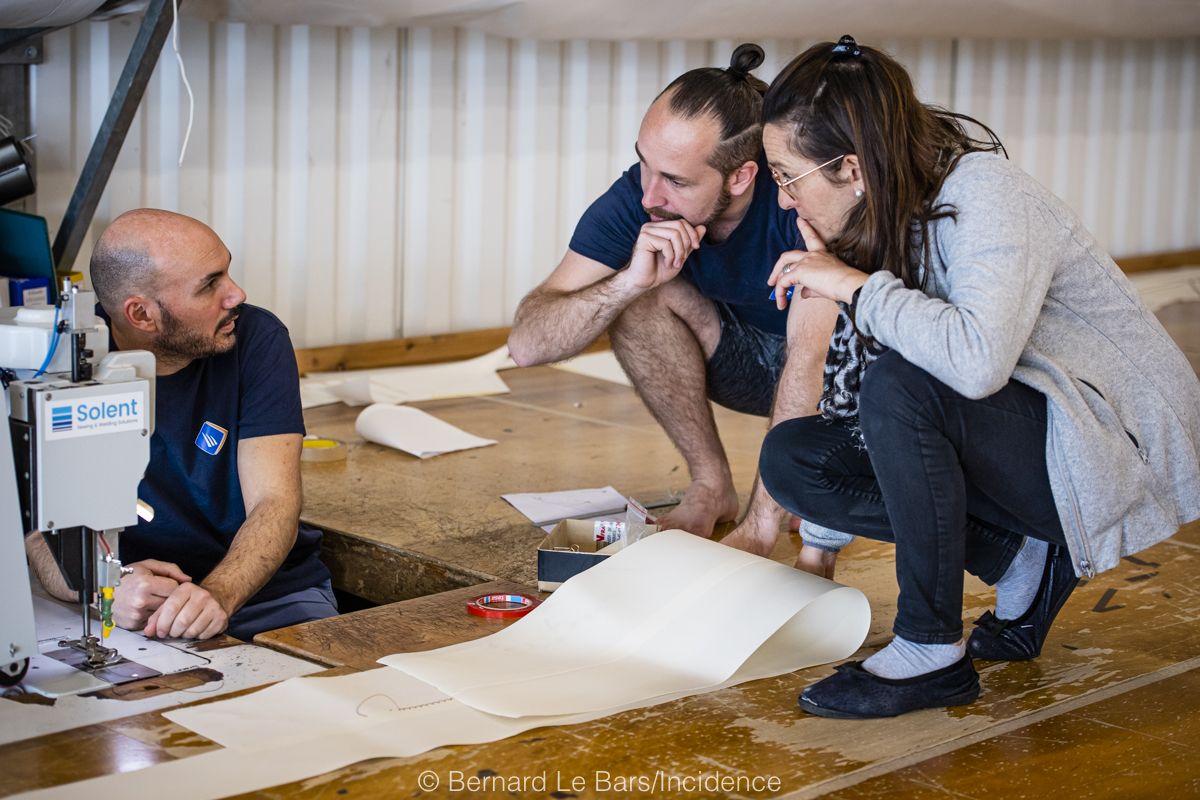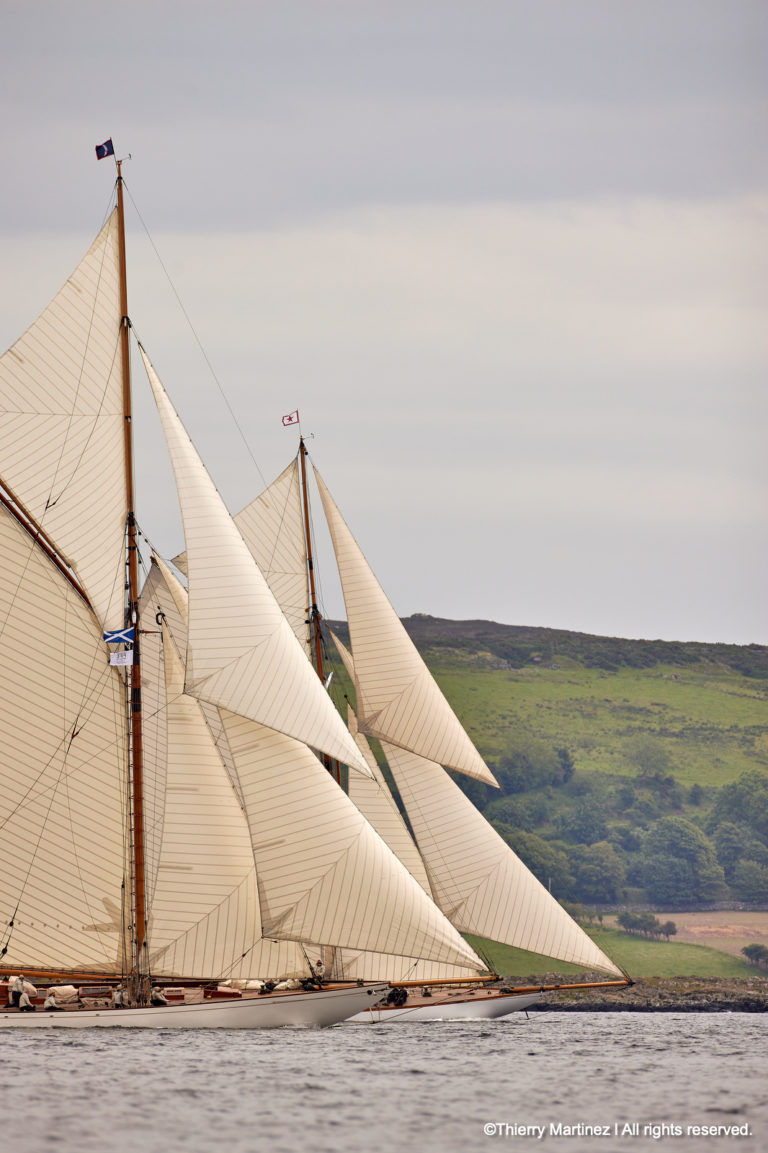classic sails, a whole story
Back to the past
September 20th, the superb silhouette of Maraquita appears in the bay of Brest.
The renown Fife plan had just been purchased by Benoit Couturier, car collector and genuine lover of beauty and authenticity.
A few months later, the two Moonbeam in turn, sail towards the Brittany’s famous harbour. The ‘Fife team’ is brought to life. Benoit Couturier wishes to create a dynamic in the Classic Yachting in Brest.
The shipowners of these three historical sailing yachts wishes them to retrieve their original appearance as faithfully as possible. Every event should be as faithful as possible to the historical reality of the Yachts, starting of course, with the sails.
« They are motivated and are doing an amazing job »
The owners of the renown Fife plans Mariquita, Moonbeam et Moonbeam IV have chosen Incidence to renew the set of sails of their magnificent yachts – dating of the beginning of the century- with highly demanding specifications in terms of authenticity. « The Incidence Team is doing an amazing work » says Benoit Couturier, owner of Mariquita.

Authenticity investigation
Benoit Couturier, owner of Mariquita : « we compared Incidence with another sailmaker, Ratsey & Lapthorn.
According to the samples, possibilities offered by the sailmakers and with the assurance that Incidence would create a «Classic Yacht » department, we decided to work with them. After that,we started working with the objective of pursuing excellence, and added specific requirements ».
Jacques Caraës, responsible for the three Fife plans : « The Incidence team is highly mobilized around this inspiring project : they have worked using ancestral know-how, and the result goes beyond our expectations. The cloth, colors, seams, reinforcements and eyelets : it really is an incredible job. We are going to have beautiful sails ».

To have the feeling

If we are not fully satisfied, we start again from the beginning
This desire has been driven by a constant quest to reach out towards perfection.
« During testing, when we were unable to achieve the desired outcome, everyone got involved».
It was impossible for us to fail, even on one small detail and we couldn’t let go on the slightest imperfection.
« We have constantly worked together as a team to give our best. It really is tailor –made ‘haute couture’. Everyone here agrees with this kind of commitment. If we are not 100% satisfied, we start again from the beginning ».
This challenge is racing us to the top
The Incidence team has searched for historical documentation in order to gather precious information on the materials and equipments used at the beggining of the century, to built those incredible yachts.
A huge amount of work was put in by the team : « There has been a lot of pressure, and there still is, but this challenge is racing us to the top. It’s an excellent job ».

Benoit Couturier : « The reason I chose Incidence was their promise to work on a set of sails that would be faithfull to its original appearance. As an example, the cloth of old spinnakers was dyed in dye baths. Therefore, the color on the cloth was never homogenous, it went from dark colors to light colors. I asked the Incidence team to respect the same technique. We will be the first ones in the world to have spinnakers that are going to look like the originals, with a range of light and dark colors !
I often visit the sail loft in Brest to have an overview of the work… I have never had anythink to say. The incidence team is motivated, they are doing an excellent job. Moonbeam IV’s set of sails will be one of the greatest on the circuit ; it will be homogenous as it is the entire set of sails that is being done in Brest, 15 sails total. It’s rarely the case. We are looking for perfection within the respect of history while looking for consistency ».
Important details
The cloth
The cotton used to craft the sails at the beginning of teh century no longer exists. The Incidence team has decided to use Dacron, already used for all the classic sails they work on. « We have selected the more flexible dacron we could find to closely meet the features of cotton so as the boat would regain its former behaviour. The aim being the search for authenticity before performance » says Stéphane Delanoë.
Providers have been interviewed, a number of samples have been studied. A selection was presented to Messrs. Couturier et Caraës.


Fabric color
Through meticulous research and documentation, the Incidence team decided on specific color. Neither too light nor too yellow or brown….
« There were numerous exchanges with our partner, fabric supplier. We had to make sure he would be able to replicate the color we selected regarding the quantity we required. This work on the color started in september 2021 with meetings in Amsterdam and Paris. Orders were placed in december ». The fabric was delivered in february 2022.
Tooling
Studying the documents of this period, the team was able to identify the equipments and tooling used by sail makers at the time, and had to build them in order to obtain the same finishes then the ones they had at the time.
« For example, in order to have an elegant sewn-in eyelet, we needed parts that cannot be found anymore. We therefore decided to manufacture them ourselves ».
All the material used to make these classic sails were specifically produced in-house.


Harware
The sail maker works with an art foundry based in Brest. « They created the moulds according to our specifications. Thus, we were able to offer parts that no one can find on the market anymore. We discussed the use we would have for every parts : the alloy the most adapted to our needs, how to keep a slight rough touch, the aesthetic appearance… The foundryman is putting all his know-how and passion for metal to produce in small series.
« There has been enriching exchanges between us all »
Ropes
Here again, providers have been interviewed. A number of ropes were sampled and tested in order to gather good mechanical characteristics, but also the aesthetic finish of the hemp used in ancient times. « This raw material is then used by the sail maker according to the headline or reinforcements they have to work on ».


Leather
« It really wasn’t easy : we needed to find the right thickness, the proper treatment, the right color. We have been looking for a long time…everywhere…and ended up finding the perfect material at our neighbour’s, who is a rigger : a thick tough leather, in the wanted color and made in France ! »
Still, the prior reaserches were enriching and confirmed the team’s final choice.
The stitching
The seams have to be straight. The slightest mistake on a zig-zag seam using brown thread on a 20 m lenght off-white cloth shows immediatly.
« We have improved our technique, especially with Sébastien Fustec, and manufactured small machine tools that helped us to secure the machines. In the end it really is the talent of the tailors that makes everything possible ! ».


Fonts and sail numbers
Some research was carried out to find the fonts that were used for the sail numbers of the very first sails of both Mariquita and the Moonbeams.
The logo
At the request of the Classic Yachts shipowners, the sail maker created for itself a new logo, in the spirit of the last century, that will fit the aesthetics and authenticity of these legendary yachts.

Jacques Caraës : « The result goes beyond our expectations »
« With Benoit Couturier, we decided that the sails had to be made in France. We chose Incidence because they had the necessary know-how and offered proximity service.
The specifications were highly demanding in terms of quality, which was perfectly understood by Stéphane Delanoë. Benoit Couturier makes high demands on aesthetics : from the materials to the finishes…
For example, the eyelets had to be sewn and not stamped. We really wanted ancient workmanship to prevail over this project.
The Incidence team was fully mobilized around this project : They have brought to life ancestral know-how and the result goes beyond our expectations.
What I have seen in the sail loft meets the specifications. The cloth, colors, seams, reinforcements and eyelets : it’s an incredible job. We are going to have beautiful sails ».

Les Ateliers de l'Enfer

A core team, Stéphane Delanoë, Jérémie Guillermou and the designer Jean-Baptiste Péron have pursued a collaborative approach with meticulous research and documentation, sampling, testing, dealing with suppliers, the shipowners and Jacques Caraës, skipper of the yachts.
Stéphane Delanoë : « It really was an enriching experience to share with all these experts. In house, we were able to cross-fertilize existing know-how : a couple of us have worked at the Ateliers de l’Enfer in Douarnenez : Marie, Jérémie and myself…
We have had the same trainor Louis-Michel Le Dose, who has a passion for ancestral techniques used by sail makers.
We brought together our knowledge, we agreed on techniques and started the testing. Jeremie began sewing the cloth, undoing, redoing…
Hand-sewing an eyelet seams easy, but for it to be nice and strong, round and well balanced you have to find the correct way to adjust the parts, so that they stay in place while sewing ; and the seam needs to appear slightly, but should not be too thick so that nothing holds to it.
We share and overcome difficulties together.
The work is great, meaningful and unifying for the team. You need to have a passion for these kind of sailing yachts but also share it with others within the project. »



